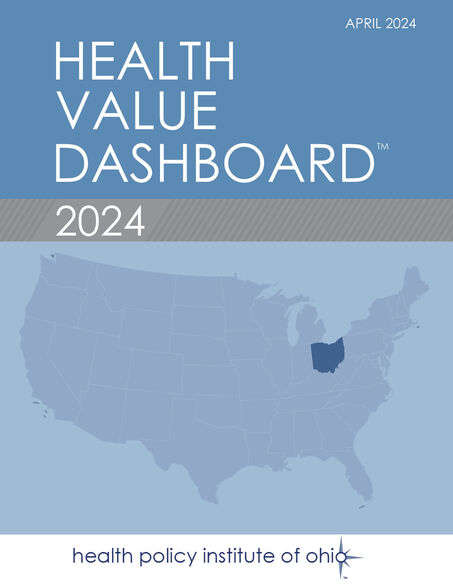2024 Health Value Dashboard
HPIO's biennial Health Value Dashboard is a tool to track Ohio’s progress toward health value — a composite measure of Ohio’s performance on population health outcomes and healthcare spending.
The Dashboard examines Ohio’s performance relative to other states and D.C., tracks change over time, identifies and explores health disparities and inequities in Ohio, highlighting evidence-informed strategies that can be implemented to improve Ohio’s performance.
The 2024 Health Value Dashboard is the sixth edition of this publication. HPIO released previous editions in 2014, 2017, 2019, 2021 and 2023. This edition of the Dashboard is being released only one year after the last edition. HPIO has decided to publish the Dashboard in even years to better align with the development of the biennial state operating budget, with future releases on a biennial basis.
Downloads:
- Methodology
- Data appendix
- Equity appendix
- Facts & Figures (PowerPoint with data graphics from the report for public use)
Note: An earlier version of the Dashboard had an incorrect number on page 5. The correct rate of avoidable ED visits is per 1,000 enrollees. Updated versions of the Dashboard and Snapshot were posted on 4.15.2024.
Policy priorities to improve health value
Ohio policymakers have many options to build on Ohio’s assets to create opportunities for prosperity and well-being throughout the state. Below are 12 policy options to improve health value, based on 2024 Dashboard findings.
Mental well-being
- Improve access to telemental health services and reduce existing barriers for patients, such as gaps in insurance coverage and lack of broadband availability.
- Fund programs with evidence of mental health benefits, such as mental health first aid, cross-age youth peer mentoring and trauma-informed schools.
- Improve the behavioral health crisis system, including the 988 lifeline and mobile crisis response, ensuring that these services are adequately funded and available across the state.
Tobacco and cannabis prevention
- Establish state-level tobacco retailer licensing and fund robust public health enforcement of “Tobacco 21” age restrictions.
- Implement marketing restrictions on tobacco and cannabis products and prohibit product types that are attractive to children and adolescents (including flavors and products that look like candy).
- Ensure that Ohio’s new cannabis regulatory framework balances important policy goals such as protecting youth health and promoting equity.
Healthcare affordability
- Establish a healthcare cost study commission to examine the key contributors to high healthcare spending, as well as ways to lower costs for consumers and employers, such as those created in Indiana and other states.
- Ensure timely access to primary care, mental health, substance use disorder and dental services by strengthening provider network accuracy and adequacy and increasing provider workforce capacity.
- Monitor the results of the new federal All-Payer Health Equity Approaches and Development (AHEAD) model, through which the federal government will collaborate with selected states to improve health, advance health equity and reduce healthcare cost growth.
Creating opportunities to thrive
- Increase the presence and accessibility of green spaces and parks that provide environmental and health benefits to communities, prioritizing areas that have historically lacked access to green spaces.
- Increase food access for Ohioans most at-risk of food insecurity through initiatives such as the Special Supplemental Nutrition Program for Women, Infants and Children (WIC) and Senior Farmers’ Market Nutrition Programs.
- Use health equity impact assessments to identify the potential health impacts of proposed policies, programs and services on systematically disadvantaged groups.
By:
Hailey Akah, JD, MA
Nick Wiselogel, MA
Carrie Almasi, MPA
Becky Carroll, MPA
Lexi Chirakos, PhD
Published On
April 9, 2024
Table of Contents
 Download Publication
Download Publication
